Industry outlook: Excavation equipment
Small excavation equipment is taking the market by storm as job sites get more compact and congested.
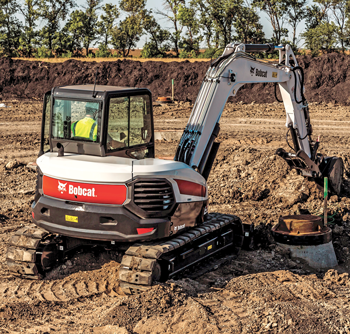 |
|
Mini excavators are becoming the tool of choice for many excavation jobs. |
Mini excavators, in many instances, are replacing backhoe loaders on work sites because of their smaller size and nimble operation.
Pro Contractor Rentals asked leading excavation experts to share their insights on this burgeoning equipment category and how it can positively affect rental centers.
 |
Jason Boerger
Marketing Manager
Bobcat Company
Compact excavators driving market
Compact excavators, especially in the 3-metric-ton size class, continue to grow in popularity across many applications. The increased utilization can be seen in residential construction, landscaping, infrastructure and utility work
As a trend, more customers purchase compact excavators than tractor loader backhoes for excavating, trenching and grading applications. A compact excavator normally has a smaller frame, which means it can fit into tighter spaces where larger machines like a tractor loader backhoe just can’t access. Compact excavators also provide great versatility because of the number of attachments that can be used on the machines, such as augers, clamps, breakers and plate compactors that make compact excavators even more versatile, and help customers be more efficient on their jobsites.
New technologies on compact excavators help customers increase productivity. For example, Bobcat Company has updated its controls to include a second auxiliary thumb toggle that lets operators switch between the second auxiliary and the boom-offset without letting go of the joystick.
Outside the cab, electronic components on the new Bobcat R-Series machines meet or exceed military requirements for sealing, moisture, shock and vibration. The units also have an automatic track-tensioning system that maintains proper track tensioning for maximum track life and simpler maintenance.
Overall, compact excavator technology continues to be a benefit for rental centers because the updates are very intuitive. Rental centers need to discern what makes sense for their fleet, and whether it will benefit their business and their customers’ needs.
Rental companies look at utilization and total cost of ownership. They routinely look at attachment options, which is a large opportunity. They look at which attachments a machine is capable of operating and which attachments are provided by the OEM.
Rental companies are more diverse than they used to be which also provides greater opportunity. Attachments provide an even greater opportunity for rental centers and are critical for increasing utilization.
One of the biggest concerns for the rental company is machine delivery, so smaller is often better, especially for short-term DIYers. Three-metric-ton machines ae smaller and easier to transport. On the other hand, rental companies that cater to longer-term use see more opportunities with eight-metric ton excavators because those machines have more power and can handle even larger jobs. Although the volume is at three-metric tons and smaller, the eight-metric-ton class is growing and provides great revenue opportunities for rental centers.
 |
Ed Brenton
Product Marketing Manager
Case Construction Equipment
Good fit for rental
Different couplers and attachments are always catching people’s attention—anything that will get the job done quicker. 1D depth-only and 2D depth-and-angle grade systems can save time and eliminate the need to have someone hold a grade rod or have the operator constantly get in and out of the cab. Our Leica system specifically can keep grade with the use of any laser level by notifying the operator of how close to their final depth they are with an in-cab monitor.
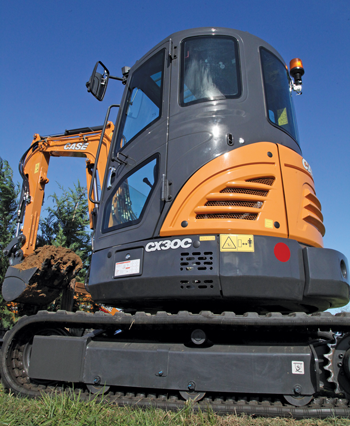 |
| Zero tail-swing units such as the Case CX300 model allow them to work in compact areas. |
Technology found on excavation equipment is allowing rental houses to monitor equipment hours, machine maintenance intervals and the location of their equipment with the use of telematics systems. This helps keep machines running longer by tracking machine use in real time.
Anything that can be adjusted from the inside of the cab of the machine is also a big help to the end-user, such as the ability to change auxiliary flows for different attachments, or the ability to change the pattern of the controls from ISO to SAE.
Landscaper offers a great opportunity for renting small excavation equipment. From a business perspective, it doesn’t always make sense to purchase a machine, as they may only need the machine for one or two jobs a year, and may not need it again for another year or two. Renting a machine makes much more sense for a business owner in that scenario. Having a few machines outside the store with rental rates posted on the machine can also draw in the do-it-yourselfer to get a project of their own started. Smaller machines can be towed behind most pickup trucks so it can make sense for someone to rent a machine for a day and save some time and energy as opposed to shoveling for hours and days on end.
Greg Worley
Product Application Specialist
Caterpillar
Equipment must meet changing challenges
Customers continue to want the machine that meets their application criteria. For example: power, performance, dig depth and reach in the smallest package possible. As building plots continue to get smaller and homes are built closer together, the working envelope gets smaller. The customer needs the right equipment than can get in to do the job.
Controlling the cost of technology on smaller machines is a challenge. The benefits need to outweigh the costs. Some technology offerings can be as much as the original machine cost, however, progressive specialty rental houses and specialty application customers understand the value of the benefits Technology on mini excavators will continue to grow as the industry continues to grow and develop especially in the indoor, alternative power sector.
Mini excavators are viable pieces of equipment in nearly all applications in some shape or form. They are easy to use and transport and are small but powerful. Customers do not work in the same way as they have in the past. Safety and labor challenges alone push customers to demand machines that allow them to do the jobs quickly and efficiently.
 |
Derek Betcher
Rental Marketing Manager
John Deere
Versatility brings popularity
Excavators offer the versatility, transportability and productivity customers are demanding on jobsites of all sizes, so the market growth for these machines has been strong and steady. This has been particularly true for compact excavators under 10 tons, including the John Deere 30G compact excavator, which has been a popular addition to the John Deere excavator line.
The John Deere 35G and smaller excavators may not need to be transported by a CDL-licensed driver – an attractive selling feature for rental centers.
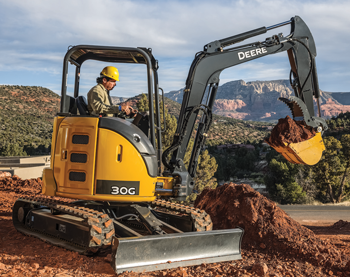 |
| John Deere G-series mini excavators feature longer service intervals, which translates into more uptime and lower ownership costs. |
Rental centers are more commonly adding hydraulic thumbs to excavators of all sizes increase machine versatility. These attachments also make jobsites safer.
The technology that is now integrated into excavation equipment make it more reliable and provide a higher ROI to rental centers. John Deere equipment offers longer hydraulic oil and engine oil change intervals, which saves owners time and money. With service intervals of 500 hours on engines on models 26G and larger and 2,000 hours on hydraulics means less maintenance time and cost.
They are designed to be simple and feature smooth, predictable hydraulic controls. This helps renters of all experience levels complete tasks more efficiently. Every John Deere compact excavator comes standard with pattern changer and auxiliary hydraulics; power mode and auto-idle are other features that can improve productivity.
Almost half of compact excavators enter the market through rental, and that’s because almost everyone can use a compact excavator. Construction, landscaping, trenching are popular uses and agriculture and underground construction industries are also increasingly using compact excavators. In underground construction especially, the compact excavator is perfect for delicately digging around utilities, which is particularly important in cities. Compact excavators are maneuverable enough to fit into small spaces in residential or commercial areas without disturbing the land.
 |
Jeff Jacobsmeyer
Product Manager
Kubota
Greater versatility, greater demand
The compact excavator market is growing in all regions of the US as customers continue to discover the versatility and power of this size of machine. 2018 is on track to be another good year for sales.
Compact excavators in the 50 horsepower and below category typically weigh 6 metric tons or less and are easy to transport. They offer digging depths close to 13 feet. They are lighter and more compact than a traditional tractor loader backhoe. Transportation to the job site is easier in urban areas with the compact excavator because trailer and truck requirements are less and sometimes no CDL license is required.
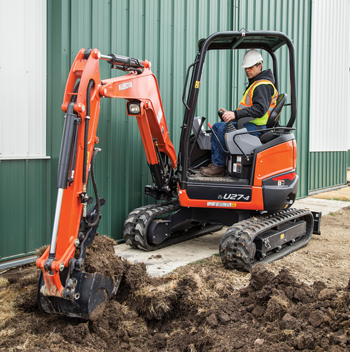 |
| Some compact excavators, like this Kubota U-27-4 model, feature booms that can dig next or very close to foundations and other obstacles on developed job sites. |
A compact excavator has the ability to run hydraulic driven attachments in a physically smaller, lighter, footprint. Each year, new model introductions continue to improve bucket breakout forces and hydraulic flow rates on top of an already impressive list of performance specifications, making compact excavators a clear choice for excavation jobs.
Careful attention has also been given to design features for operator space and comfort. Current models include more floor space, roomier cabs, deluxe suspension seats and low-effort controls. Efficient heating and cooling systems allow for all-day comfort compared to machines just a few years ago that struggled to keep the cab comfortable.
Technology is advancing faster than ever on new excavation equipment. Remember when a cell phone only made phone calls? Soon we will say, “Remember when an excavator only dug holes?” Job timers, electronically adjustable flow control and depth and grade control settings are features that help make jobs run more efficiently. As technology evolves, renters will be able to take more advantage of advantage of what the machine’s capabilities Telematics can provide machine location, mechanical health and other information that is commonplace with larger equipment.
As we go forward, the cost of technology will most likely come down and consumer demand will require that rental machines be equipped with this technology as a standard feature. The prevention of over dig or under dig can save time and materials on any jobsite. If a trench is dug too deep it will cost more in gravel and concrete to backfill. If a trench is not deep enough, there can be a host of other issues
Rental markets have remained strong in 2018 and rental fleets are updating and even increasing in total size due to rental demand. Compact excavators continue to be a popular replacement of the tractor-loader-backhoe.
Today’s modern pilot controls are smooth and easy to learn. If one ever played a video game with any success it will not take long to learn the controls on a compact excavator equipped with pilot controls. Daily and weekly rentals usually fetch a higher price and provide good profit to a rental center because they are sometimes only needed short term.
Joe Boufford
Marketing Specialist
New Holland North America
Small package, big power
The 50 horsepower range excavators fall in the compact classification of up to 6 metric tons. Compact excavators are all about big power in a small package. They need to be versatile to get the most out of the machine; and ergonomic to allow for comfortable all day operation; and precise because they are often used in tight spaces.
Many compact excavator trends are about operator convenience with functions such as blade float and auto-shift that takes some of the burden off the operator.
Another trend is the utilization of compact excavators for more than just digging. They are as versatile as the available attachments. Though not built for land speed, excavators are designed and optimized to deliver constant, powerful hydraulic flow. This allows a digging machine to become a breaker, cutter, mower, compactor, or auger. A hydraulic or mechanical coupler enables the user to switch easily between attachments. These machines are also being used more in landscaping, estate management and specialty agriculture.
Even in the equipment business, information is key and the industrial internet of things (IIoT) is changing the way companies do business. Fleet management systems allow rental houses to keep track of their assets and also allows for planned service scheduling for routine maintenance and service parts orders. Telematics systems have the ability to transmit error codes back to a monitoring center so appropriate action can be taken.
There is also a long-term green trend for alternative energy sources, such as battery, alternative fuels, or hybrid technology.
It is important to have excavators in the rental fleet that can be operated by non-professionals and are capable of lighter duty work. Compact excavators are perfect for this scenario as most models can be transported without a CDL, are small enough to work alongside structures, while offering enough power and precision for the application.
Availability and versatility of attachments is key. Having a machine that can utilize multiple attachments creates more opportunity as it increases the breadth of possible applications. This allows rental yards to penetrate untapped markets while giving the renter the ability to accomplish multiple tasks once limited to different tools or equipment.
Another opportunity for equipment retailers is to use the rental business to demo equipment to potential buyers. Customers are more apt to make a purchase when comfortable with the product and more likely to stick with a brand with proven performance.
Lee Padgett
Product Manager
Takeuchi U.S.
Need for fleet management increases
The newest improvement for Takeuchi equipment is Takeuchi Fleet Management (TFM). TFM can remotely connect users to their machines. TFM provides alerts and machine information including location, performance, and maintenance data, giving insight into where and how the equipment is being utilized.
Rental houses and end users benefit from TFM because it can help them save time and money by having the ability to track their assets remotely, schedule downtime for maintenance and identifying issues before they become costly repairs, saving substantially on repair costs. Having the machine data before a tech goes out on a call allows the technician to be better prepared for the specific needs of the machine. They are also able to track their entire fleet of Takeuchi equipment remotely, which helps with equipment moves, asset security, maintenance needs and making sure the machines are being operated properly. It can help minimize the company’s exposure to issues that can arise from excessive idling and other practices that result in higher maintenance costs.
We have seen a growing need for machines that can operate with zero emissions. Takeuchi offers the TB216H dual-power excavator that is able to operate in either diesel or full electric mode. While this is a niche market and some customers may think they do not have a need for this machine in their fleet; it does create greater opportunity for rental houses to meet the needs of their customers for a low- or no-emission solution.
 |
Kent Somerville
Director, National Rental Accounts
Volvo Construction Equipment
Auxiliary circuits improve versatility
One of the biggest trends in excavation equipment is requests for additional hydraulic circuits. A third circuit was commonly requested; now customers want a fourth function. Further, thumb attachments have become a rental standard, which helps prevent inexperienced operators from putting too much pressure on the machines. They make it easier to grab and load materials.
All of Volvo compact excavators up to the 50 horsepower range are very popular right now. Customers benefit from the diverse Volvo lineup of six excavators under 50 horsepower that fit various needs and skill levels. Customers want durability, excellent hydraulics, ability to work in tight spaces and fuel efficiency. For instance, the Volvo ECR58D offers a short swing radius, excellent control and low fuel consumption at 49 horsepower. The EC20D is a 16 horsepower machine equipped with a tough rear counterweight and casted digging equipment for maximum durability.
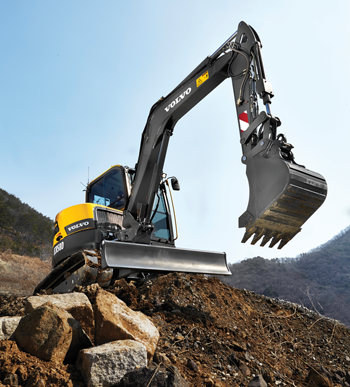 |
| The new Volvo mini excavators offer a short swing radius, excellent control and low fuel consumption, Volvo sources report. |
Telematics is changing the game for rental houses. It’s a feature that can add value and longevity. Rental houses are using telematics to monitor a machine’s location and whether it’s running, to get alerts if it’s moved out of a certain location, to track service intervals and be more proactive with repairs.
Excavators above 50 horsepower that require Tier 4 Final engines with exhaust emission control. With this added emissions components, there is a need for service technicians who have a better understanding of how these systems work and how to troubleshoot problems. While rental houses have learned how to service Tier 4 final-complaint engines to get a longer service life out of the components, they still want to have the simplest machine possible and the least number of features.
Compact excavators are a core rental machine for most full-line construction equipment rental houses. Their versatility makes them popular with everyone from a homeowner to large construction companies. Part of that popularity is their versatility, thanks to the large number of attachments that can be used with compact excavators. This segment appears to be growing at a higher pace than other compact equipment types. Machines are offered in conventional and reduced tail swing versions, which makes it easier to work within confined spaces.
 |
Jay Quatro
Field Application and Training Specialist
Wacker Neuson
Competition encourages differentiation
The under 50 horsepower size range is currently the most competitive in the mini excavator market. Almost every major equipment manufacturer offers machines in this size class. Although many of the changes and trends in small excavation equipment are small and incremental, the operator still demands top-notch performance and reliability. This leads manufacturers to look outside the box for ways to earn their customer’s business.
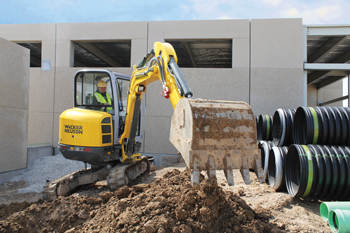 |
|
The Wacker Neuson Vertical Digging System (VDS) allows the operator to level the operating platform of the excavator up to 15 degrees to compensate for uneven terrain. |
At Wacker Neuson, we recognize the importance of maximizing the contractor’s uptime. Our history in mini excavators goes back more than 30 years to Europe where some of the first mini excavators were developed. Since then, Wacker has kept up with the major trends in the industry including zero tail swing, multiple dipper and cab options and Tier 4 Final engine emission compliance. A closer look at Wacker Neuson excavators reveal smaller, yet important details such as one-piece booms, larger than average steel bushings and tilting cabs for unparalleled maintenance access.
Wacker Neuson has also developed an exclusive feature on select models called Vertical Digging System (VDS). This allows the operator to level the operating platform of the excavator up to 15 degrees to compensate for uneven terrain and digging conditions.
While performance always matters, longevity and a company that stands behind its equipment is necessary in today’s competitive and saturated equipment landscape. To differentiate Wacker Neuson from the rest of the pack, Wacker Neuson offers an industry-leading five-year/5,000-hour warranty power train and hydraulics on all of its excavators.
Telematics are rapidly advancing in small excavation equipment. Using satellite and cell technology, owners can receive data remotely, collecting information such as GPS location, hours and even engine operation. This can give the owner or rental house insight into machine efficiency and troubleshooting. Another way to use this technology is for tracking use and setting automatic reminders for service plans.
There are two metrics that are extremely important to a rental house; return on investment (ROI) and utilization. Construction conditions and seasons vary across North America, so it is important from a manufacturer’s perspective to build machines that can be competitive in the greatest number of applications possible.
Small excavators can be rented to a variety of construction industries including landscaping, utilities, demolition and even small residential projects. Features that make Wacker Neuson excavators versatile in a rental fleet that are available on select models are zero tail swing and expandable undercarriages. Rental centers can benefit from the versatility of standard auxiliary hydraulics plumbed to the dipper on every machine.
Wacker Neuson also offers small hybrid excavator, the 803 Dual Power model. This unit can run on its internal diesel engine or with an optional electro-hydraulic power pack for zero emissions operations. This flexibility allows a rental house to cater to more customers with one machine.
Originally published in the July-August 2018 issue of Pro Contractor Rentals. magazine. All rights reserved.









